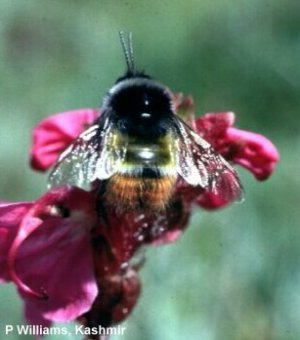|
|

B.
himalayanus male mate-searching.
|
Mendacibombus
ecology
and behaviour
HABITAT:
High alpine grassland and mountain meadows.
FOOD-PLANTS: Medium
tongue-length bumblebees visiting medium-depth
flowers.
NESTING
BEHAVIOUR:
Nests underground. Larvae are reared in separate
cells throughout their development, non-pocket
makers. Food reserves are held in hexagonal wax
cells outside the brood-nest envelope (Haas, 1976).
MATE-SEARCHING
BEHAVIOUR:
Males have enlarged compound eyes relative to
the females. Six species studied perch (e.g. photo
left), race after potential mates, and may be
truly territorial (Williams, 1991
[pdf]).
|
Subgenus
MENDACIBOMBUS Skorikov
Mendacibombus
Skorikov, 1914a:125,
type-species Bombus mendax Gerstaecker by subsequent
designation of Sandhouse, 1943:572
Bombus (Mendacibombus) Krüger, 1917:62
Part
of the bumblebee phylogenetic tree including available
Mendacibombus species from an analysis of DNA
sequence data for five genes (Cameron
et al. 2007
[pdf]).
Values above branches are Bayesian posterior probabilities,
values below branches are parsimony bootstrap values.
Bombus
(Md.) superbus (Tkalcu)
superbus (Tkalcu, 1968a:22
[Mendacibombus]) examined
2 names
TAXONOMIC
STATUS: Although ostensibly described from Mongolia
(probably a mislabelling), this species is endemic to
some of the higher parts of the Tibetan plateau.
DISTRIBUTION:
Oriental Region.
Bombus
(Md.) waltoni Cockerell
chinensis Skorikov,
1910a:330, examined,
not of Morawitz, 1890:352
(= B. chinensis
(Morawitz))
waltoni Cockerell, 1910b:239,
examined
5 names
MORPHOLOGY:
photos of male genitalia.
DISTRIBUTION:
Oriental Region.
Bombus
(Md.) convexus Wang
lugubris Morawitz,
1880:339, examined,
not of Kriechbaumer, 1870:159
(= B. maxillosus
Klug)
convexus Wang, 1979:190,
examined
2 names
MORPHOLOGY:
photos of male genitalia.
DISTRIBUTION:
Oriental Region.
Bombus
(Md.) makarjini Skorikov
makarjini Skorikov, 1910a:329,
examined
4 names
MORPHOLOGY:
photos of male genitalia.
DISTRIBUTION:
Palaearctic Region, Oriental border.
Bombus
(Md.) himalayanus (Skorikov)
?varius (Skorikov,
1914a:125 [Mendacibombus])
examined, not of Lepeletier, 1832:381
(= B. campestris
(Panzer))
himalayanus (Skorikov, 1914a:127
[Mendacibombus]) examined
5 names
MORPHOLOGY:
photos of male genitalia.
DISTRIBUTION:
Oriental Region.
Bombus
(Md.) turkestanicus Skorikov
turkestanicus Skorikov, 1910a:329,
examined
1 name
MORPHOLOGY:
photos of male genitalia.
DISTRIBUTION:
Palaearctic Region, Oriental border.
Bombus
(Md.) defector Skorikov
defector Skorikov, 1910a:329,
examined
1 name
MORPHOLOGY:
photos of male genitalia.
DISTRIBUTION:
Palaearctic Region.
Bombus
(Md.) marussinus Skorikov
marussinus Skorikov, 1910a:330,
examined
afghanus Reinig, 1940:230,
examined
4 names
MORPHOLOGY:
photos of male genitalia.
DISTRIBUTION:
Palaearctic Region, Oriental border.
Bombus
(Md.) avinoviellus (Skorikov)
avinoviellus (Skorikov, 1914a:126
[Mendacibombus]) examined
callophenax Cockerell,
1917:122, examined
6 names
MORPHOLOGY:
photos of male
genitalia.
DISTRIBUTION:
Oriental Region.
Bombus
(Md.) margreiteri Vogt
altaicus Skorikov,
1910a:329, not
of Eversmann, 1846:436
(= B. melanurus
Lepeletier) examined
margreiteri Vogt in
Skorikov, 1910a:330,
examined
2 names
TAXONOMIC
STATUS: Skorikov's (1910a)
descriptions of varieties of B. mendax are all
of females. Many of these nominal taxa have subsequently
been treated as separate species (e.g. Skorikov, 1931;
Rasmont, 1988).
However,
I have examined type material or other material identified
by Skorikov for all of these taxa and find some of them
to be morphologically closely similar. The females of
the white-banded taxon altaicus and the yellow-banded
taxon margreiteri differ from one another principally
in colour, and the only males I have seen associated
with them (collections in London, Amsterdam, St Petersburg,
Beijing, Sapporo) have closely similar genitalia (which
are distinct from B. mendax).
Until more evidence to the contrary is available from
critical studies of patterns of variation, I shall continue
to treat the taxa altaicus and margreiteri
as parts of a single variable species, B. margreiteri.
DISTRIBUTION:
Palaearctic, Oriental Regions.
Bombus
(Md.) handlirschianus Vogt
Handlirschianus Vogt, 1909:49,
examined
shaposhnikovi Skorikov, 1910a:329
3 names
TAXONOMIC
STATUS: The white-banded taxon handlirschianus
and the yellow-banded taxon shaposhnikovi differ
principally in female colour pattern. Some males associated
with the two taxa have appeared to differ in morphology
(Skorikov, 1931; Williams,
1991 [pdf])
and consequently the taxa have been treated as separate
species. More recently the distinctness of the males
has been questioned and mixed colonies have been found
(De Meulemeester et al., 2010).
Furthermore, evidence from comparisons of DNA sequences
from five genes is consistent with the two taxa being
conspecific (Cameron et al., 2007
[pdf]).
MORPHOLOGY:
photos of male
genitalia.
DISTRIBUTION:
Palaearctic Region.
Bombus
(Md.) mendax Gerstaecker
mendax Gerstaecker, 1869:323,
examined
latofasciatus Vogt,
1909:50, not of Vogt,
1909:42 (= B. lucorum
(Linnaeus)) examined
pyrenes (Tkalcu, 1975:173
[Mendacibombus]) unnecessary replacement name
for latofasciatus Vogt, 1909:50
14 names
MORPHOLOGY:
photos of male genitalia.
DISTRIBUTION:
Palaearctic Region.
|